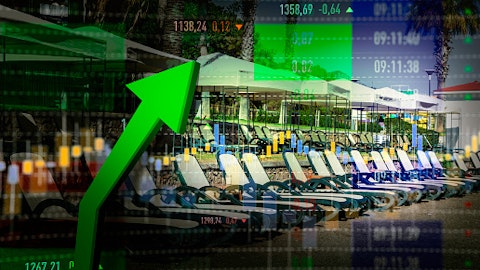Roger Dassen: Yes, of course. Down payments were helpful, right? So as a result of that, I do — you did see that in the second quarter, in the last quarter Q4 free cash flow was quite positive at €2.6 billion just for the quarter, primarily driven, as you say, by down payments. But it’s also fair to see that we are in ramping mode. We are preparing for a ramp in 2025 and that means we’re taking in materials. We’re building inventory for High-NA, et cetera, et cetera. So I think on the inventory position, you would see that we’re adding quite a bit. So that is obviously a negative, if you like, to the free cash flow. But still, overall, I think the €2.6 billion that we recorded in the last quarter, I think, was a healthy — was a healthy cash generation.
Operator: And your next question comes from the line of Stephane Houri, ODDO BHF.
Stephane Houri: Yes. Actually, the question is about the 2025 acceleration. My feeling is that you sound a bit more comfortable on the fact that this strong acceleration is going to happen? And I remember you’re saying that you are targeting the middle of the range. But at the same time and I’m sure you didn’t miss this one, consensus has come down really to the lower end of the guidance for 2025. So can you maybe tell us if you are still targeting the middle of the range, at least? And what do you need to see in terms of Memory recovery, Logic orders coming through to 2024 to reassure that?
Peter Wennink: Yes. Yes, Stephane. Yes, yes, I mean we feel a bit more comfortable on 2025 after having received €9.2 billion of orders which, especially in the EUV domain, it’s focused on 2025. So I think you get the vote of confidence from our customers on what we thought was going to happen which is always good. When you talk about the middle of the range, I said — my comment was that I thought the low end of the range was too conservative. That’s what I said. I can make it in the middle of the range or the high end of the range. It’s your choice but I’m not going to comment on that because that would give me in January 2024 — the 24th of January, give you an outlook or if you give you guidance on 2025. I mean it might be a bit early.
So — but I do feel directionally, that’s what I said. I said the low end, I thought it was too conservative because we do believe that 2025 is going to be a very strong year. Well, the order intake actually gives us at least some level of confidence that, that statement at that time was actually quite good. So I feel more comfortable. Yes, that’s absolutely true. Now if the recovery in 2025 is indeed what we expect. Yes, we should see a further order flow in 2024. Our lead time, order lead time is 12 to 18 months. So yes and that’s what I also said last time, if we’re right on 2025, we need to see orders coming in, in the first half of 2024. Now we’ve seen a significant batch of those orders already coming in, in Q4 2023. So that just supports our assumptions.
So in that sense — now make a long story short, yes, I feel more comfortable, I think, with me our colleagues.
Stephane Houri: Okay. And regarding the memory market as a follow-up, is it really the start of the recovery of investment in memory? Or is this just all that is related to AI, DDR5, HPM? Or is it wider in your view?
Peter Wennink: Well, I think it’s — what we’re seeing is, of course, the information coming off our tools that we see the utilization rates going up. That’s one. Clearly, there’s also an element of technology transition. That’s also clear. I think there’s a bottleneck in the AI and making use of the full AI potential, DRAM is a bottleneck. The performance memory is a bottleneck. And there are solutions but they need a heck of a lot more HBM and that’s EUV; so it’s a bit of a mix. I mean, yes, you’ve gone through, I think, the bottom of this memory cycle with prices going up; utilizations increasing. And that combined with the technology transition driven by AI. That’s a bit what we see today. So it’s a combination of both and I think that will continue.
Operator: And your next question comes from the line of Sara Russo from Bernstein.
Sara Russo: So you’ve said you’re expecting strong demand from China to continue in 2024. Is that expected to be sort of at the same level we’ve seen for the last few quarters where it’s been exceptionally strong? Or is there some rebalancing you’re expecting across global demand expected for later in the year as we get towards that growth expectation for 2025?
Roger Dassen: Well, I mean, we’re not going to be specific at the beginning of the year exactly on China. But I think a few data points that we want to share with you. First off, as we also said in the video, we do see the demand from China being very robust. Second, there is an impact, obviously, coming out of the export controls. And Peter just gave you that impact, the 10% to 15%. So I think fundamentally, it’s pretty clear that the China demand remains very strong. As we said before, it’s primarily driven towards mature and met critical notes. I mean that’s what it’s all for. It’s a bit too early to speculate exactly how the China demand is going to pan out because that’s also dependent on how the demand for the rest of the world is going to pan out because as you know, from previous years, we have allocation questions, right?





